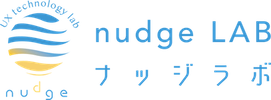
nudgeとは行動経済学の専門家であるRichard Thaler, Cass Sunsteinが提唱した理論で, 人が自らの行動を決定する時に, 自発的に望ましい方向に誘導するには,nag(しつこくガミガミと言うの意)よりもnudge(ちょっと後押しするの意)な仕掛けや手法が良い結果を導くという説です.
シンプルな仕掛けで大きな成果をあげた有名な事例では,オランダの首都アムステルダムのスキポール空港の男子トイレの便器内に描かれたハエの絵の仕掛けがあります.
小さなハエの絵だけで利用者の行動変容を促し,男子トイレの清掃負荷が大きく減少したと言われています.他にも金融サービスや公共サービスにも個人に選択の余地を残しながらより良い 行動を選択するよう促すnudge的サービス設計が効果的であると言われ,結果的に個人のwell-beingを高める手法として注目されています.
nudge LABは人の五感や知覚,行動の特性を活かしたUser eXperience(UX)技術をベースに,自発的に望ましい方向に人を誘導する仕掛けや手法を創造し,あらゆる人のwell-beingの実現を目指します.
Nudge is a theory proposed by
Richard Thaler and Cass Sunstein, who are experts in behavioral economics.
It is the theory that nudge gimmicks and
methods voluntarily lead to better results of people when to decide their actions rather than nag them forcefully.
A well-known example that has achieved great results with a simple nudge gimmick is a picture of fly drawn in the toilet bowl of a men's toilet at Schiphol Airport in Amsterdam, the Netherlands.
Just a small fly picture in the toilet bowl successfully induces people use it cleanly and cleaning load on the men's toilet is greatly reduced. In addition, it is said that nudge encourages individuals to make better choices
such as financial services and public services, and as a result, it will be noted as a method to improve individual well-being.
nudge LAB aims to realize well-being for all people by creating a system and method to guide a person to a desired direction spontaneously based on User eXperience(UX) technology that makes use of the characteristics of human senses, perceptions, and
behaviors.

